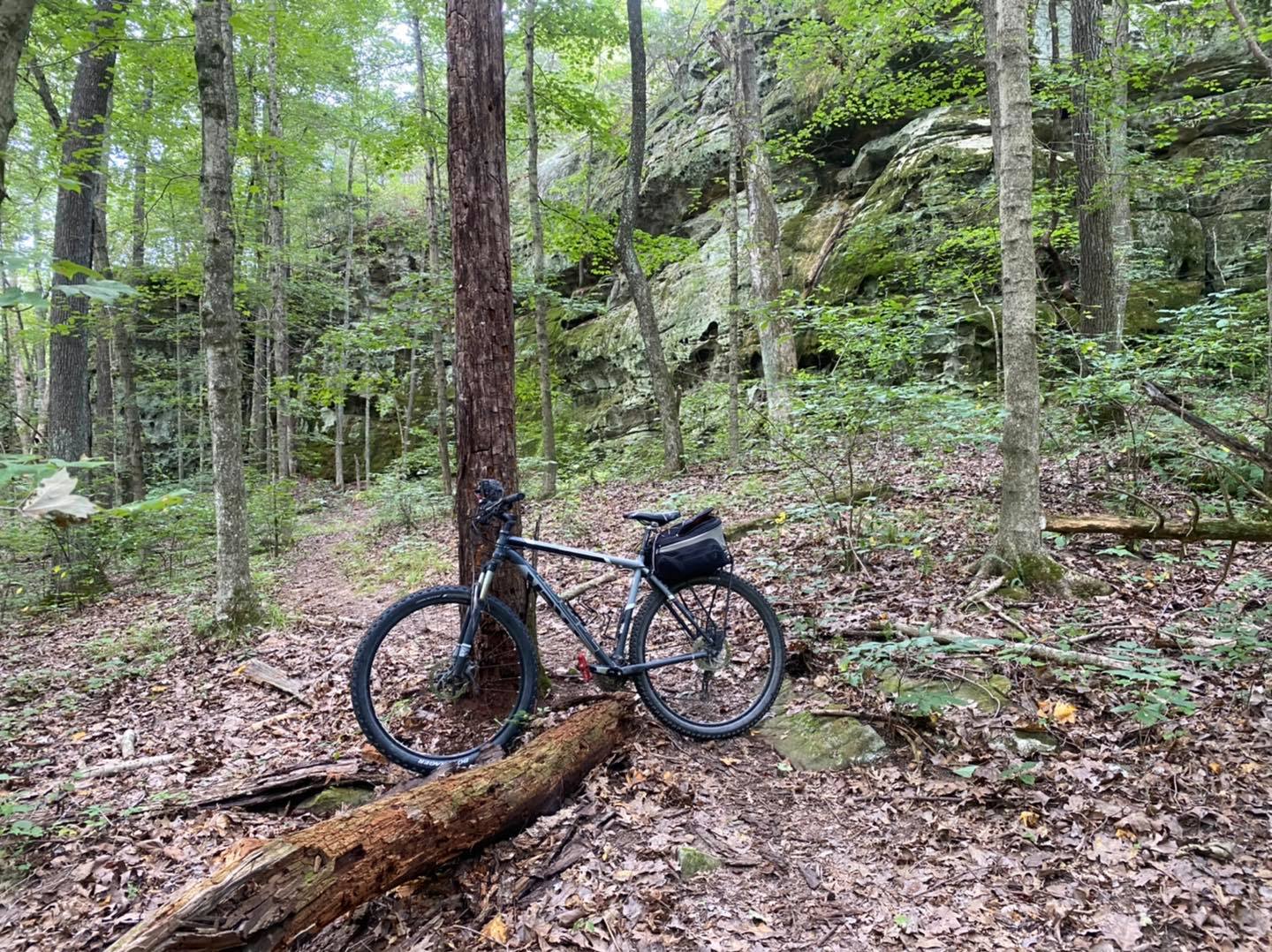Ultimate Bikepacking Gear List: Bikepacking Essentials for Any Trip
Knowing what bikepacking gear list items you should take on your overnight biking adventure is important.
There are many bikepacking essentials that riders typically forget to take, only to regret leaving these items behind after they get too far away from where they started. You can avoid this by knowing what biking gear you must take.
I wanted to make this bikepacking gear list to serve two purposes.
The first purpose is to give you an ultimate list of bikepacking essentials. The second purpose is to suggest alternative lists and tips for ultralight bikepacking if you decide you want to try that instead.
Now let’s get on with the list.
Disclaimer: This article contains affiliate links. These links do not affect the cost of items for you. Alternatively, you can search for these items on search engines instead.
Ultralight vs. Full Bikepacking Gear List
There is a difference between ultralight and full bikepacking gear list recommendations.
The first step is understanding the difference between ultralight and non-ultralight bikepacking.
Regular bikepacking is when you load up everything you need for a multi-day biking adventure. Sometimes bikepackers stay in hotels or an Airbnb. Most of the time, bikepackers camp in campgrounds or primitive spots on public land. Regular bikepacking takes all the necessary gear to make the trip comfortable.
Ultralight bikepacking, on the other hand, take as little gear as possible. This type of overnight cycling focuses on the exclusive bikepacking essentials that are absolutely required and leaves the rest of the gear at home. Being lightweight is the ultimate goal for ultralight bikepacking gear list recommendations.
In this article, I’ll focus on full bikepacking gear and follow it with ultralight bikepacking essentials and tips for those who require less weight.
But as a disclaimer – make sure you bring enough gear to ensure you have a safe bikepacking trip. Never sacrifice required gear and safety just because you must have a lighter load.
Bikepacking Bikes and Routes
First, let’s look at the various bike and route options for the best possible bikepacking gear list recommendations.
Road Bikes
A road bike is typically lighter but has skinny and slicker tires. This means that these bikes are best ridden on paved and smooth road surfaces. They are not usually good bikes for dirt or gravel pathways. If your bike packing trip consists of all paved surfaces, a road bike might be a great option. They also make road-styled touring bikes which will typically be the best option for this. If you want the lightest option possible for a road bike, get something made out of carbon fiber, but remember that it will have a higher price tag.
Gravel Bike
If your road combines paved, gravel, trails, and dirt roads, you might consider getting a gravel bike instead. A gravel bike is much like a road bike but has aggressive tires for different terrains. It’s like the all-terrain vehicle of bicycles. A cyclocross bike is a lot like a gravel bike in many ways. A carbon fiber gravel bike will be best to reduce weight and help with the shock of riding on gravel. Look for gravel bikes made for bikepacking and touring for better storage bag addition options.
Mountain Bike
A mountain bike can ride on any surface but is best ridden on technical dirt and rock trails in a singletrack and hilly environment. Mountain bikes are made for extreme conditions. A mountain bike will probably be your best option if you plan to bike through a steep and rugged forest. Mountain bikes are typically heavy but can also be purchased in carbon fiber frames and components to help reduce weight.
Try to plan out your route, research the roads and trails you plan to take, and then decide on the best bike for the job before you choose your bike first and make a mistake that you’ll later regret.
Bikepacking Tools
The following bikepacking tools are important to add to your bikepacking gear list:
- Pocketknife
- Spare tubes or tire sealant
- Compact air pump or CO2 inflator with cartridges
- Tire levers
- Multi-tool for bicycles
- Chain links (replacement)
- Chain breaker
- Lubricant
- Duct tape
- Zip ties
- Patch kit
For an ultralight alternative, consider only taking:
- Multi-tool
- Patch kit
- 1 Tube
- CO2 inflator with 2 carts
- 1 tire lever
- Duct tape wrapped around a water bottle
Bikepacking Helmet
Try to ensure that you bring a sturdy bike helmet with you. This is especially important if you plan to ride on roads with motor vehicles or on technical and rugged trails. The last thing you want to do is wreck and hit your head. The helmet should be made for cycling and in good condition. Helmets with damage or cracks should be discarded and replaced with new ones free of deformities. Skipping on this important piece of gear could lead to major injuries or even death.
Bikepacking Bags
There are many bikepacking essentials regarding what type of bags to add to your bike. It will depend on the type of bike you choose to bring at the end of the day. But here are a few bag options to consider:
- Saddlebags (for mountain and gravel bikes) or rear panniers (for road bikes)
- Handlebar pack
- Frame pack (for mountain and gravel bikes) or rear panniers (for road bikes)
- Hydration backpack or waist pack
- Smaller backpack
- Gear trailer or child trailer
Ultralight Tip: Try to just bring a large saddlebag and hydration backpack and fit everything you need in those packs to weigh less.
Bikepacking Lights
Having essential lighting is important for your safety and to be able to see in the dark. Here are some bikepacking essentials when it comes to lighting:
- Rear (red light with flash option)
- Front (clear light with low, medium, high, and flash options)
- Headlamp (for camp)
- Extra batteries or power brick with charging cord
To be ultralight, consider a front and rear light only and use the front light sparingly for camp.
Bike Lock
Make sure you bring a basic but secure bike lock. If you must stop at a store or any other place in a public setting, you want to ensure you can secure your bike. Smaller locks to secure bag openings may also be ideal. A good secure bike lock is something on the bikepacking gear list that many cyclists forget and regret forgetting when they need it the most because anything is possible, and you might have to stop somewhere.
Camping Gear
It’s essential to take the right kind of camping gear with you if you plan to bikepack in nature. Here is the gear that you should consider taking with you:
- Tent, Tarp, Bivy, or hammock
- Sleeping bag (if cold: liner) or quilt
- Sleep pad
- Inflatable pillow
- Camp seat pad
- Camp games/cards
- Gear repair kit
Alternatively, for an ultralight option, as long as it can be done safely, the gear recommended would be:
- Tarp or bivy (lightest)
- Sleep bag liner or quilt (lightest)
Cooking Gear
When bikepacking, you want to make sure you bring the correct cooking gear. Here are the best cooking gear list options to choose from:
- Pocket rocket stove
- Fuel canister
- Lighter or matches
- Cook cup (for food and drinking)
- Spork
- Bear canister (if in bear country)
Alternatively, for less weight, you could bring these items instead:
- Pocket stove
- One small fuel canister
- Small cook cup
- Plastic fork
- Bear bag hung up with paracord away from camp (if in bear country)
Fuel and Hydration
These bikepacking essentials are the most important bikepacking gear list items to take with you:
- Water (bottles, bladder, etc.)
- Water filter or tablets
- Water bottle cages
- Electrolyte tablets
- Energy bars, gels, and gummies
- Jerky
- Fruit
- Dehydrated meals
- Rice or noodles
- Large Ziploc bag for trash and waste
The only ultralight tip I have is that you research and know for sure if there is water in the creeks where you can filter as needed to help reduce water weight. But you have to ensure there will be water available, or it could lead to a disaster for you.
Bikepacking Clothing
The following items are best to take with you for clothing on and off the bike:
- Cycling jersey (long sleeve if cold)
- Cycling windbreaker (cycling jacket if cold)
- Padded bib-shorts or cycling shorts (tights if cold)
- Bike shoes
- Shoe cover (if cold)
- Cycling socks (extra pair)
- Rain gear
- Bike gloves (cold weather gloves if cold)
- Leg/arm warmers and neck/face cover if cold
- Sports bra
- Sleepwear (insulated layers if cold)
- Camp shoes (flip-flops or Crocs)
- Air-activated hand warmers
- Sunglasses or safety glasses
Alternatively, to reduce weight, only take what you wear when you start biking. Use layers and shed them (and add them) as needed. Sleep naked to let your body air out. You might stink for a few days, but at least you shed weight off your ride.
Navigation
Navigation is important to keep you from getting lost. These bikepacking essentials will help you stay on the right path:
- Map (paper, phone, or both)
- Compass
- Portable charger and phone cord
- GPS device
- Personal locator beacon (just in case)
- Required permits, if any (don’t knowingly violate the regulations and get kicked out)
- List of services along the route
Ultralight alternative gear includes:
- Plastic compass and paper map lighter than GPS
- Personal locator beacon (just in case)
- Bring a phone and keep it turned off unless emergency
Personal Bikepacking Gear List
These items don’t really fit any category aside from the personal items category:
- Sunscreen and lip balm
- Bug spray
- Hand sanitizer
- Toothbrush and toothpaste
- Biodegradable soap
- Toilet paper
- Small shovel (to bury waste)
- Wet wipes
- Menstrual products and pee rag
- Prescription medication
- Chamois cream
- Small first aid kit
- Camera
- Watch
- Journal and pen
- ID, Cash, and Credit Card
- Cellphone
Alternatively, you can buy small containers to transfer these items in to reduce their amount and weight.
And that sums up your ultimate bikepacking gear list. These bikepacking essentials will ensure that you can enjoy the entirety of your cycling adventure. The ultralight alternatives and tips will help you reduce weight. You can also reduce weight by buying ultralight gear, which typically costs more. Sometimes you can find alternatives in stores that are not exactly made for bikepacking, can serve the same purpose, and weighs less.
If you enjoyed this article and would like to support my efforts, please share it with others and give me a small tip. Subscribe to my free newsletter for more information and resources about bikepacking and other outdoor recreation adventures.
Please Support Hiking with Shawn
Alrighty folks, I hope you have enjoyed this content. I provide it for free and it takes a while to create. If you would be so kind enough to support my efforts, you can do so by sharing this post with others, especially on social media. Be sure to subscribe to my YouTube Channel to see my latest videos, shorts and live streams. Follow me on Facebook, Instagram, Twitter and TikTok for unique content that you will only find on those pages. You might also join my Southern Illinois Hiking & Outdoor Resources Group on Facebook, too!
You can also support me by becoming a Patreon Supporter for as little as $3/month and you can cancel anytime (no contracts or catches). Patreons get access to extra features, exclusive articles, sticker packs, gifts and more. Consider buying official Hiking with Shawn Merchandise as another way to support me. I spend a lot of money on Hiking with Shawn and because of extremely high public land permit fees, I make very little money in return so everything helps.
Thanks again for checking out another one of my articles and until next time, I’ll see you on the trail!

Shawn Gossman
Founder, Hiking with Shawn
Howdy folks! My name is Shawn Gossman and I founded Hiking with Shawn. I’m an avid hiker, cyclist and outdoorsman here in the Shawnee National Forest. I was born and raised in Southern Illinois and never want to leave. Click here to learn more about Shawn Gossman


